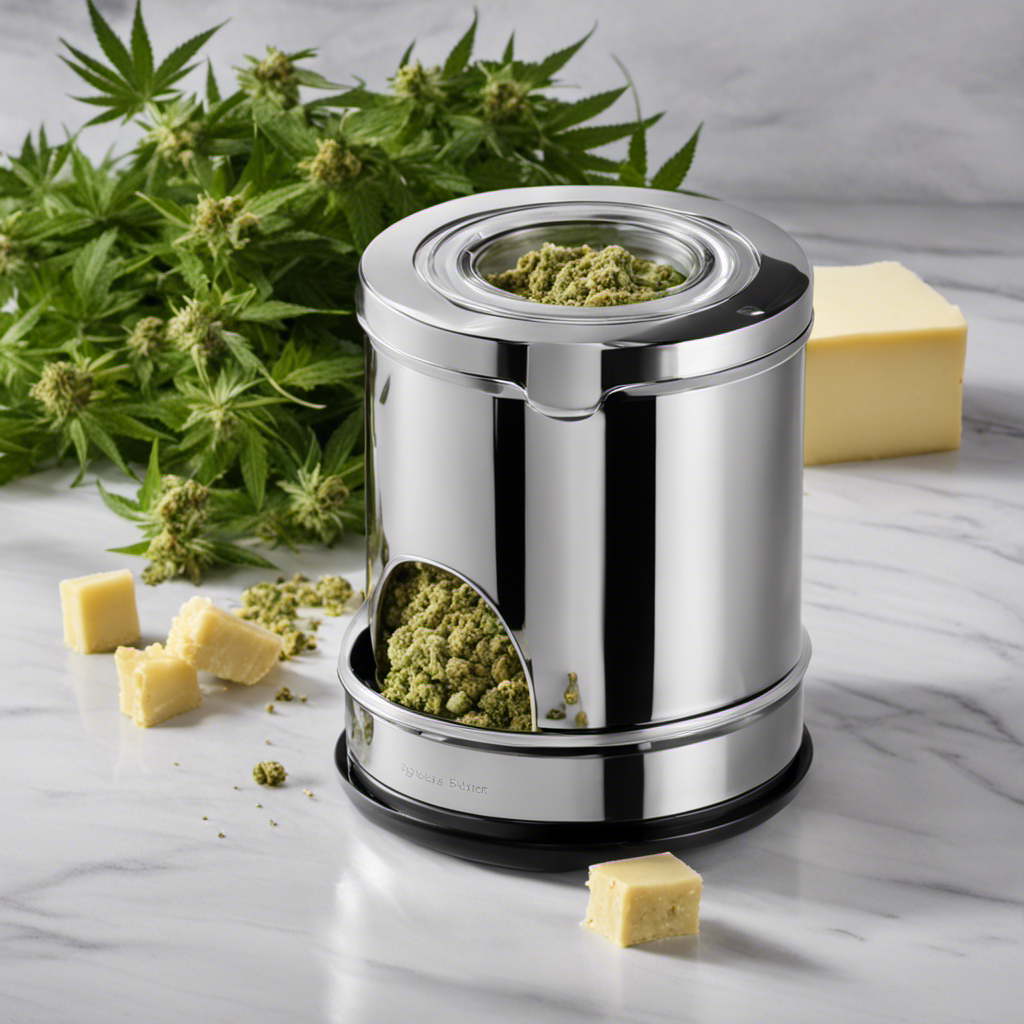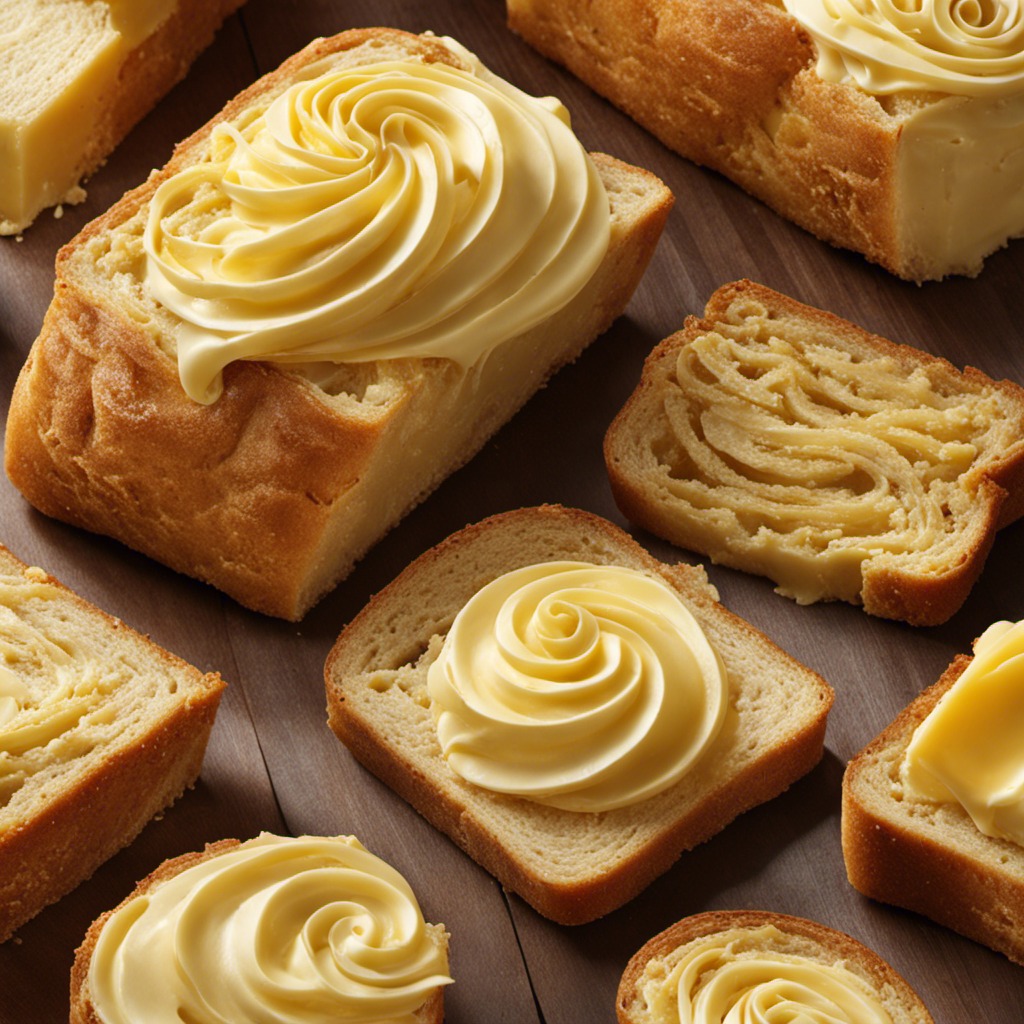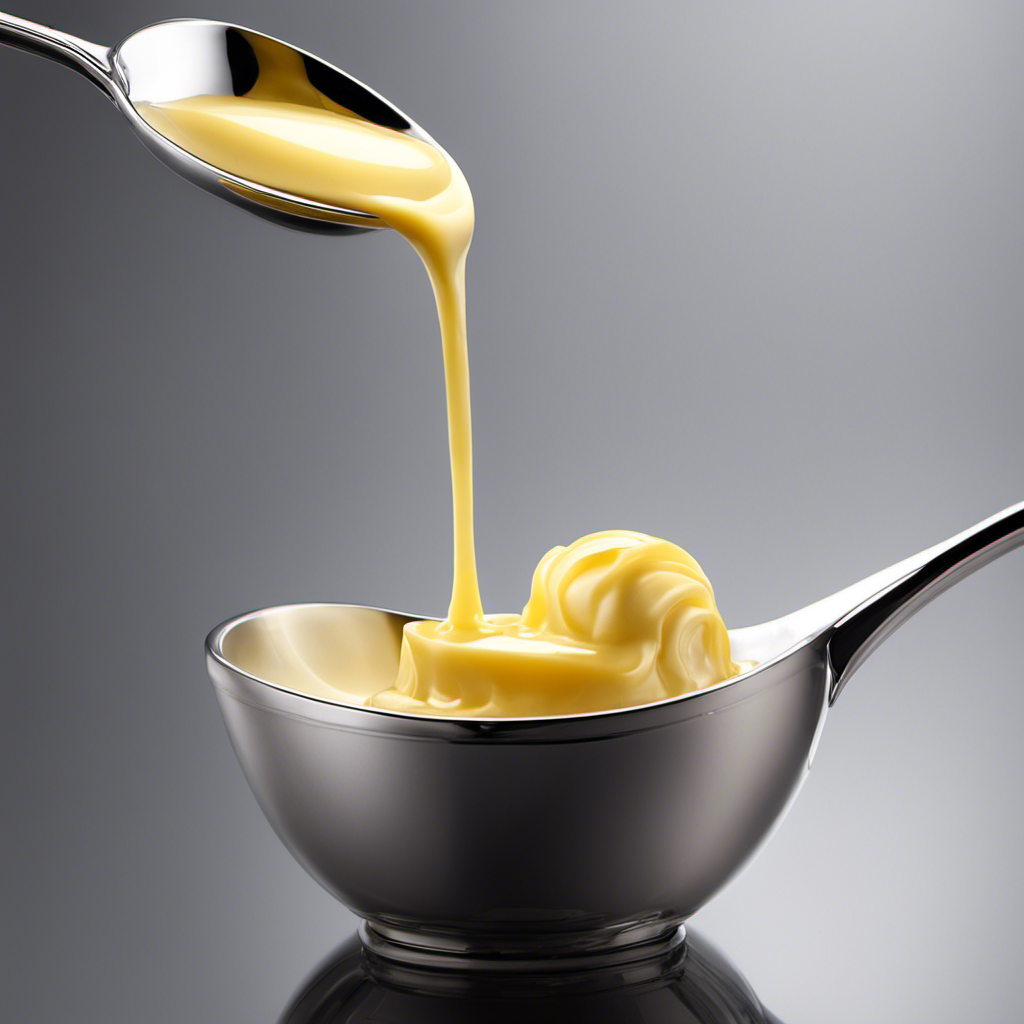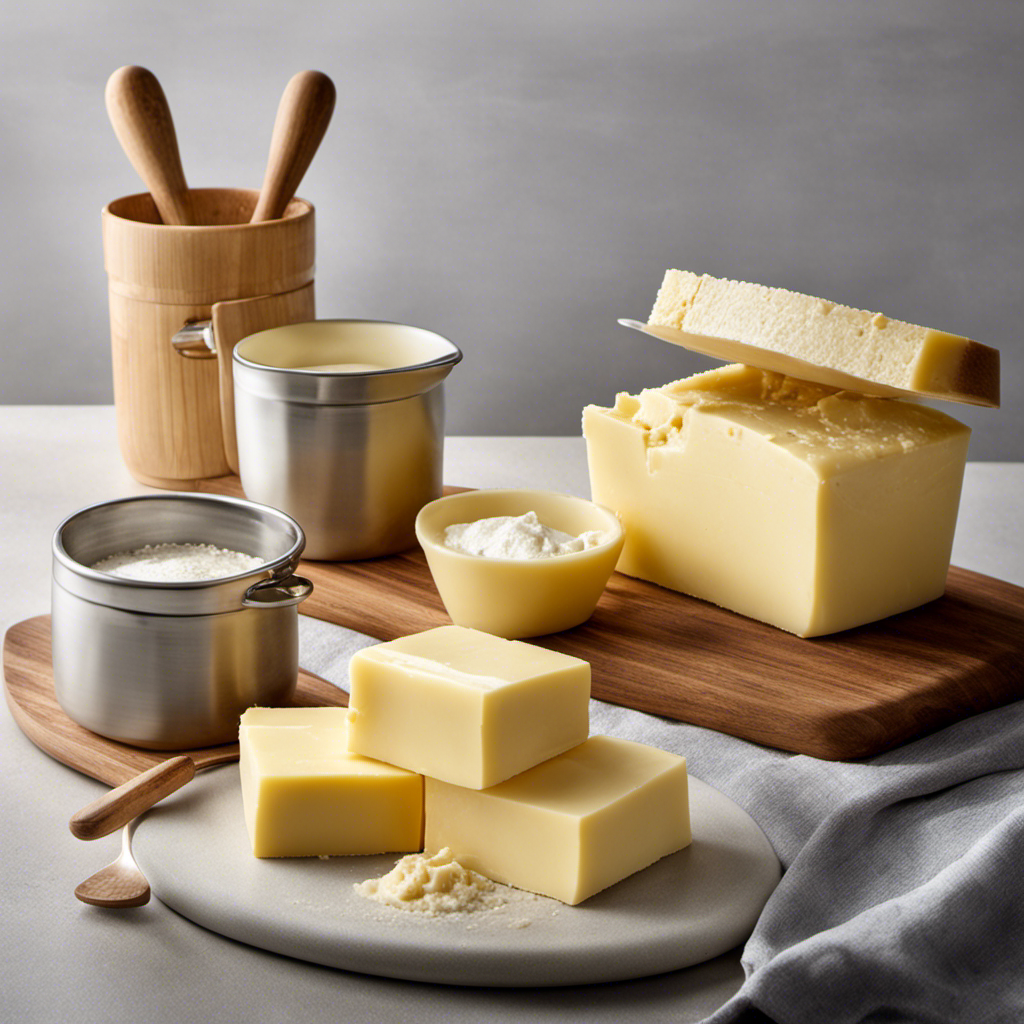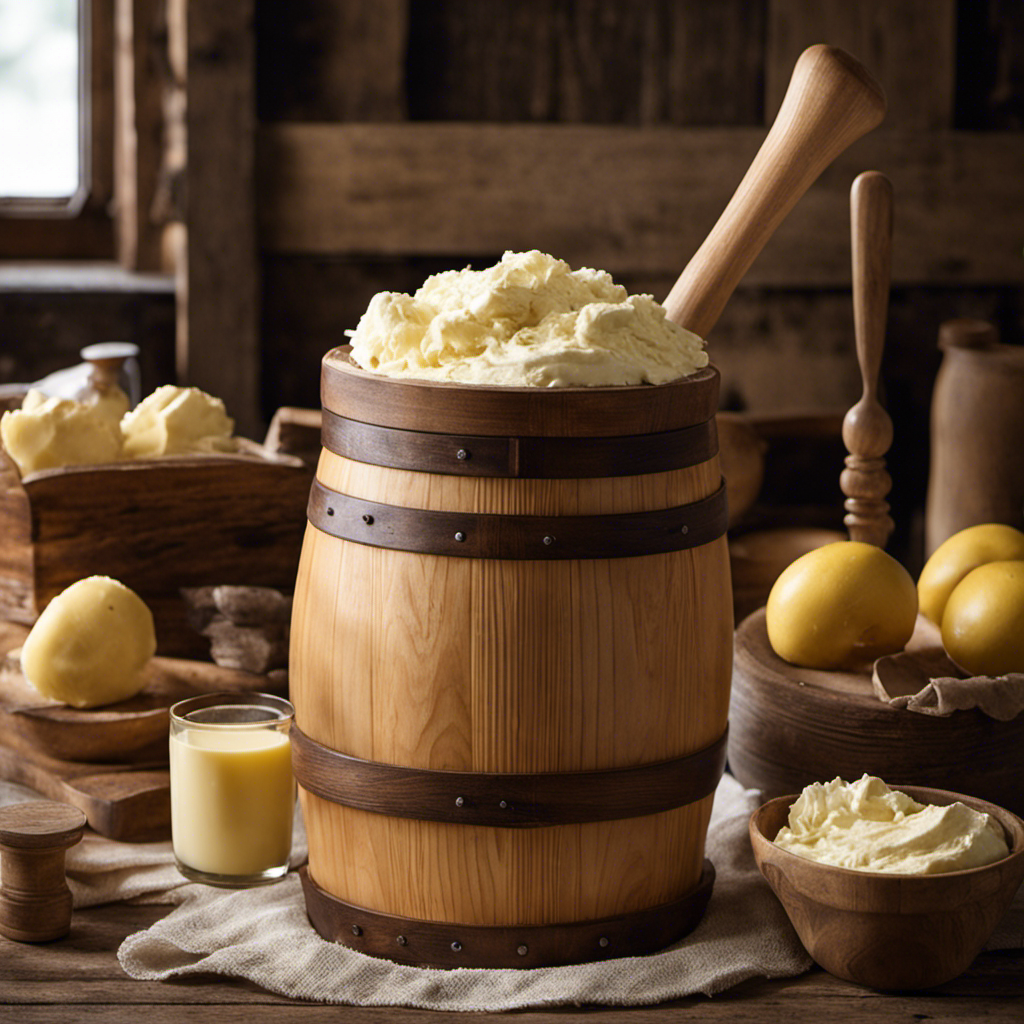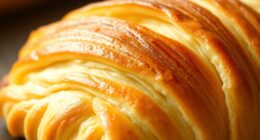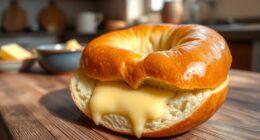I’ve often pondered the appropriate amount of cannabis to use in an Easy Butter Maker.
Well, here’s an interesting fact: finding the right balance of herb is crucial for achieving perfect cannabis-infused butter. In this article, I’ll guide you through the process of measuring the herb, selecting the right strain, and calculating the ideal weed to butter ratio.
By understanding the effects of different weed amounts and experimenting with various quantities, we can ensure consistent and flavorful results with our Easy Butter Maker.
Let’s dive in and explore the science behind weed infusion!
Key Takeaways
- Accurate dosing techniques are crucial for achieving desired effects and avoiding under or overdosing on edibles.
- Consistency in edible potency allows for a predictable and controlled experience.
- Finding the right strain and adjusting the dosage based on personal tolerance and preferences is important.
- Using a reliable scale and measuring spoon ensures precise herb measurement and consistent results.
Understanding the Easy Butter Maker
To understand the Easy Butter Maker, you’ll need to follow the instructions carefully. This device is designed to make the process of infusing butter with THC from cannabis easier and more efficient. By using accurate infusion techniques, you can maximize the extraction of THC and create potent cannabis-infused butter.
The Easy Butter Maker works by heating the butter and cannabis mixture, allowing the THC to bind with the fat molecules in the butter. This process is known as decarboxylation and is essential for activating the psychoactive properties of THC. The device ensures that the temperature is maintained at an optimal level, allowing for a consistent and effective infusion.
To achieve accurate infusion, it is important to measure the amount of cannabis you use. The recommended ratio is 1 ounce of cannabis to 1 pound of butter. This ratio ensures a potent infusion while avoiding an overpowering taste. It is also important to finely grind the cannabis to increase its surface area and enhance the extraction process.
Maximizing THC extraction involves using the Easy Butter Maker for the recommended duration, which is typically around 2 hours. This allows enough time for the THC to fully infuse into the butter, resulting in a potent and effective cannabis-infused product.
The Importance of Proper Herb Measurement
When it comes to consuming edibles, accurate dosing techniques are crucial. This ensures that you’re getting the desired effects without under or overdosing.
Consistency in edible potency is also important. It allows you to have a predictable experience every time you consume them.
Accurate Dosing Techniques
Using a scale and measuring spoon ensures accurate dosing when using an easy butter maker. Adjusting dosage is crucial for achieving dosing accuracy, especially when it comes to edibles.
To accurately measure the amount of weed to put in an easy butter maker, it is important to have a reliable scale that can measure in grams. This allows you to precisely measure the amount of herb you are using.
Additionally, using a measuring spoon can further enhance accuracy. It allows you to measure smaller quantities of ingredients, ensuring that you don’t add too much or too little.
Avoiding Under or Overdosing
Achieving accurate dosing is essential for avoiding under or overdosing on edibles. When it comes to consuming cannabis-infused treats, it’s important to calculate the potency of the product beforehand. This involves understanding the amount of THC or CBD in the edible and how it will affect your body. Calculating potency can be done by considering factors like the strain used, the amount of cannabis, and the cooking process.
Additionally, adjusting for tolerance levels is crucial. Every individual reacts differently to cannabis, so it’s important to start with a low dose and gradually increase it based on personal experience. By carefully calculating potency and adjusting for tolerance levels, you can enjoy a pleasant and controlled edible experience.
Now let’s explore the importance of consistency in edible potency.
Consistency in Edible Potency
To ensure a consistent experience with edibles, it’s crucial to carefully monitor the potency of each batch. Accurate dosing is key to achieving the desired effects and avoiding any unpleasant surprises. Potency levels can vary greatly depending on factors such as the strain used, the decarboxylation process, and the infusion method. By keeping track of the amount of weed and the strength of the butter or oil used, you can calculate the approximate potency of your edibles. Here is a table that illustrates the general potency levels based on the amount of weed used:
| Amount of Weed (in grams) | Approximate Potency Level |
|---|---|
| 1-2 | Mild |
| 3-5 | Moderate |
| 6+ | Strong |
Finding the Right Strain for Your Easy Butter Maker
When it comes to finding the right strain for your Easy Butter Maker, there are a few key points to consider.
Ideal weed strains, flavor preferences, and effects. Different strains offer different effects, so it’s important to choose one that aligns with your desired experience.
Additionally, flavor preferences can also play a role in selecting the right strain, as some strains have distinct tastes and aromas.
Ideal Weed Strains
You should consider using indica strains for your easy butter maker as they tend to have a more relaxing and sedating effect. Indica strains are known for their ideal characteristics such as calming the mind and body, making them perfect for creating butter infused with a soothing and mellow vibe. When it comes to finding the right dosage, it is important to start low and go slow. Different strains have different levels of potency, so it’s essential to experiment and find the dosage that works best for you. To give you an idea of the variety of indica strains available, here is a table showcasing some popular options:
| Strain Name | Effects |
|---|---|
| Granddaddy Purp | Relaxation, euphoria, pain relief |
| Northern Lights | Deep relaxation, sleep aid |
| Blueberry | Calming, stress relief, mood elevation |
| Purple Kush | Sedation, muscle relaxation, stress relief |
Now that you have an idea of the ideal strain characteristics and dosage, let’s dive into the next section about flavor preferences and effects.
Flavor Preferences and Effects
Flavor preferences and effects can greatly vary from person to person, so it’s important to explore different strains and find the ones that align with your desired taste and experience.
When it comes to flavor profiles, cannabis offers a wide range of options, from fruity and sweet to earthy and spicy. Some strains may have a citrusy tang, while others may have a hint of pine or even chocolate undertones. It’s all about finding what appeals to your palate.
Additionally, dosage accuracy is crucial in achieving the desired effects. Different strains have different THC and CBD levels, so it’s important to start with a low dose and gradually increase until you find the right balance. This ensures a more enjoyable and controlled experience.
Calculating the Ideal Weed to Butter Ratio
Calculating the ideal weed to butter ratio is crucial for achieving the desired potency in your homemade edibles. As someone who has experimented with infusion and tried various measuring techniques, I have learned a few key points to keep in mind.
Here are three important factors to consider when determining the perfect ratio:
-
Quality of the Weed: The potency of your edibles will greatly depend on the quality of the weed you use. Higher-quality strains with higher levels of THC will result in more potent butter. It is essential to choose a strain that suits your preferences and desired effects.
-
Desired Potency: Think about how strong you want your edibles to be. If you prefer a milder experience, a lower weed to butter ratio will suffice. On the other hand, if you are looking for a more intense effect, a higher ratio is necessary. Remember to start low and gradually increase the ratio until you find your sweet spot.
-
Personal Tolerance: Everyone’s tolerance to cannabis is different. Take into account your own tolerance level when calculating the ratio. If you are a beginner or have a low tolerance, consider using a smaller amount of weed to avoid overwhelming effects.
Experimenting With Different Weed Amounts
Experimenting with different amounts of weed is a great way to find the perfect balance for your homemade edibles. When it comes to making infused butter, the potency of your final product will depend on the amount of weed you use. Finding the right dosage is crucial to ensure that your edibles provide the desired effects without being too overwhelming.
To begin experimenting, start with a small amount of weed and gradually increase the dosage until you find what works best for you. This process allows you to gauge the effects and potency of your infused butter. Keep in mind that everyone’s tolerance level is different, so what works for one person may not work for another.
By experimenting with potency, you can tailor your homemade edibles to your specific needs and preferences. If you’re looking for a more mild effect, use a smaller amount of weed. Alternatively, if you want a stronger high, increase the dosage accordingly.
As you experiment, take note of the amount of weed used in each batch and the effects it produces. This will help you find the perfect dosage for future batches and ensure consistency in your edibles.
Transitioning into the subsequent section about maximizing the potency of your infused butter, it’s important to note that the quality of your ingredients and the infusion process can also greatly impact the final potency of your edibles.
Maximizing the Potency of Your Infused Butter
To get the most potent infused butter, it’s crucial to ensure that your decarboxylation process is done correctly. Decarboxylation is the process of heating the cannabis flower to activate its cannabinoids.
Here are three key tips to maximize infusion efficiency and enhance the flavor of your infused butter:
-
Grind the cannabis: Before decarboxylation, it’s important to finely grind the cannabis. This increases the surface area, allowing for better heat distribution and a more efficient decarboxylation process.
-
Optimal temperature and time: Decarboxylation is typically done at a temperature range of 220-240°F (105-115°C) for about 30-45 minutes. Maintaining this temperature range ensures that the cannabinoids are activated without degrading the plant material.
-
Use a double boiler: When infusing butter, using a double boiler can prevent overheating and burning. This method involves placing a heatproof bowl filled with butter and decarboxylated cannabis on top of a pot of simmering water. The indirect heat gently infuses the butter with the cannabinoids.
Tips for Accurate Weed Measurements
When measuring your cannabis, make sure to use a reliable scale for accurate results. Accurate measurements are crucial when working with weed, especially if you’re using it for cooking or making infused products. Using a reliable scale ensures that you’re getting the right amount of cannabis every time, which is essential for achieving desired effects and avoiding any mistakes.
To ensure accurate measurements, it’s important to invest in a quality scale that is specifically designed for weighing cannabis. These scales are calibrated to provide precise measurements, allowing you to accurately portion your weed. Avoid using makeshift scales or guessing the weight, as this can lead to inconsistent results and potentially ruin your recipe or product.
When weighing your cannabis, always make sure to zero the scale before placing the weed on it. This eliminates any potential errors caused by the weight of the container or surface. Additionally, it’s important to handle the weed carefully to avoid any loss or spillage, as even a small amount can significantly impact the final product.
Adjusting the Weed Amount Based on Desired Strength
After mastering the art of accurately measuring weed for your easy butter maker, it’s time to dive into adjusting the weed amount based on your desired strength. This step is crucial to ensure your edibles deliver the desired potency and experience.
Here are three key points to consider when adjusting potency:
-
Gradual adjustments: Start by using a standard measurement of weed and test the potency of your resulting edibles. If you find the strength too mild, gradually increase the amount of weed in small increments for subsequent batches until you achieve the desired potency. Conversely, if the edibles are too strong, reduce the amount of weed accordingly.
-
Personal tolerance: Everyone’s tolerance to THC varies, so it’s essential to consider your own tolerance level when adjusting potency. If you have a higher tolerance, you may need to use a slightly higher amount of weed to achieve the desired effects.
-
Experimentation and record-keeping: Adjusting potency is a trial-and-error process. Keep detailed records of the weed amounts used, the resulting potency, and your personal experience with each batch. This will help you fine-tune the measurements over time and create consistent, high-quality edibles.
Avoiding Common Mistakes in Weed Measurement
Be careful not to make common mistakes in measuring your weed for optimal potency and consistent results with your edibles. Accurately measuring your weed is essential to ensure that you achieve the desired effects and avoid any unpleasant surprises. Here are some common mistakes to avoid when it comes to weed measurement techniques:
| Mistake | Description | Solution |
|---|---|---|
| Eyeballing | Estimating the amount of weed without using a scale | Use a scale to measure the exact amount |
| Inconsistent Grind | Using different grind sizes in your measurements | Ensure a consistent grind size for accurate dosing |
| Ignoring Strain Potency | Not considering the potency of the strain when measuring | Adjust the amount based on the strain’s potency |
Eyeballing the amount of weed can lead to inconsistencies in your edibles. It’s easy to overestimate or underestimate, which can significantly affect the potency of your final product. Invest in a reliable scale to measure the exact amount of weed needed for your recipe.
Inconsistent grind sizes can also affect the potency of your edibles. Make sure to grind your weed consistently to ensure accurate dosing. Using a grinder with a consistent grind size will help you achieve better results.
Lastly, don’t forget to consider the potency of the strain you’re using. Different strains have different levels of THC and CBD, so it’s important to take this into account when measuring. Adjust the amount of weed based on the strain’s potency to achieve the desired effects.
Using Different Weed Quantities for Different Recipes
When it comes to using weed in cooking, it’s important to consider the optimal dosage and how to adjust for potency.
Finding the right amount of weed to use can greatly affect the outcome of your recipe, both in terms of taste and potency.
Additionally, knowing how to adjust for the potency of your weed ensures that you have control over the effects of your edibles.
Optimal Weed Dosage
To achieve the optimal weed dosage in your easy butter maker, you’ll want to start with a generous amount of ground cannabis. The amount you use can vary depending on your personal preference, but here are some general guidelines to help you get started:
-
Begin with a quarter ounce (7 grams) of ground cannabis. This is a good starting point for most recipes and will provide a moderate potency.
-
If you prefer a stronger dosage, you can increase the amount to half an ounce (14 grams) of ground cannabis. This will create a more potent butter or oil that can be used in smaller quantities.
-
For those looking for a milder dosage, you can start with an eighth of an ounce (3.5 grams) of ground cannabis. This will result in a less potent infusion that can be used in larger quantities.
Adjusting for Potency
Adjusting the potency of your infusion is simple. Start with a smaller amount of ground cannabis if you prefer a milder dosage. When making edibles, it’s important to find the right balance of potency to maximize the effects. By adjusting the amount of cannabis you use, you can tailor the potency levels to your liking.
If you’re new to edibles or prefer a more subtle experience, start with a smaller amount and gradually increase it until you find your desired potency. On the other hand, if you’re experienced and looking for a stronger effect, you can increase the amount of cannabis to achieve a more potent infusion.
Remember to always start low and go slow when adjusting potency levels to avoid any unwanted side effects.
Adapting the Weed Amount for Personal Tolerance Levels
If you’re not sure how much weed to use in the Easy Butter Maker, it’s important to consider your personal tolerance levels. Dosage is a crucial factor when it comes to making edibles, as it determines the potency and effects of the final product.
Here are three key points to keep in mind when adapting the weed amount for your personal tolerance levels:
-
Start low and slow: If you’re new to edibles or have a low tolerance, it’s best to begin with a smaller amount of weed. This allows you to gauge your body’s reaction and prevents any overwhelming effects. You can always increase the dosage gradually in subsequent batches if desired.
-
Consider your experience: Those with more experience and higher tolerance may require a larger amount of weed to achieve the desired effects. It’s important to be mindful of how much you typically consume and adjust the dosage accordingly.
-
Listen to your body: Everyone’s tolerance is unique, so it’s crucial to pay attention to how your body reacts to different dosages. If you find that a certain amount of weed is too strong or not potent enough, make note of it for future reference.
Understanding the Effects of Different Weed Amounts
When it comes to experiencing the desired effects of cannabis, finding the optimal dosage is crucial. Different individuals may have different tolerance levels and preferences, so it’s important to understand how much weed to use to achieve the desired effects.
Additionally, variations in potency levels among different strains can greatly impact the intensity and duration of the effects. Finding the right balance between flavor and potency is also key, as some strains may have a strong flavor profile that can either enhance or overpower the overall experience.
Optimal Dosage for Effects
To achieve the desired effects, it’s important to find the optimal dosage when using an easy butter maker. Determining the right weed potency can be tricky, especially for beginners. Here are three key factors to consider when determining the optimal dosage:
-
Start low and slow: Begin with a small amount of weed, such as 1 gram, to gauge your tolerance and how the butter affects you. This will help you avoid any overwhelming or unpleasant experiences.
-
Consider potency: The potency of your weed will greatly impact the dosage. If you have high-potency strains, you may need to use less weed to achieve the desired effects. Conversely, if you have low-potency strains, you may need to use a bit more.
-
Experiment and adjust: Finding the optimal dosage is a personal journey. Experiment with different amounts and observe how it affects you. Gradually adjust the dosage until you find the sweet spot that delivers the desired effects without being too overwhelming.
Variations in Potency Levels
Take into account the different levels of potency when determining your optimal dosage for the effects you desire.
It’s important to understand that not all cannabis strains are created equal. There are variations in flavor profiles and effects of different strains. Some strains may have a higher THC content, which is the compound responsible for the psychoactive effects of cannabis. Others may have a higher CBD content, which is known for its potential therapeutic benefits.
When considering potency levels, it’s crucial to consider your tolerance and experience with cannabis. Start low and go slow, especially if you’re new to using cannabis. Remember that the effects can vary from person to person, so it’s essential to listen to your body and adjust your dosage accordingly.
Balancing Flavor and Potency
When it comes to making edibles, balancing flavor and potency is key. You want your treats to taste delicious while still providing the desired effects.
Here are three ways to achieve this delicate balance:
-
Choose the right strain: Different strains have distinct flavors and potency levels. Opt for a strain that complements the flavors you’re using in your recipe. For example, if you’re making chocolate brownies, a strain with earthy undertones might pair well.
-
Control the dosage: Start with a small amount of cannabis and gradually increase as needed. This allows you to find the perfect balance between flavor and potency without overwhelming your taste buds.
-
Infuse wisely: Consider using cannabis-infused ingredients, such as infused oils or butters, to enhance the flavor while maintaining control over the potency. This way, you can customize the dosage to suit your preferences.
Achieving Consistent Results With the Easy Butter Maker
Achieving consistent results with the Easy Butter Maker can be difficult if you don’t follow the recommended instructions. Accurate dosing techniques and maximizing potency are key factors to consider when using this device. To ensure accurate dosing, it is important to measure and use the appropriate amount of weed. This will not only help you achieve the desired effects but also prevent wasting any excess product. Maximizing potency involves using the right strain of weed and determining the optimal infusion time. The Easy Butter Maker comes with a user manual that provides guidelines on how much weed to use and the recommended infusion time for different strains.
To make it easier to understand, here’s a table that outlines the recommended dosing and infusion times for common strains:
| Strain | Amount of Weed (grams) | Infusion Time (hours) |
|---|---|---|
| OG Kush | 7 | 2 |
| Sour Diesel | 10 | 3 |
| Blue Dream | 5 | 1.5 |
Exploring the Science Behind Weed Infusion
Understanding the science behind weed infusion can help you achieve consistent and potent results with this device. When exploring infusion techniques, it’s important to first understand the decarboxylation process.
This is the conversion of the non-psychoactive THCA in raw cannabis into THC, the compound responsible for the euphoric effects of marijuana.
Here are three key aspects of the science behind weed infusion:
-
Heat Activation: Decarboxylation occurs when cannabis is exposed to heat. This process breaks down the THCA into THC, making it available for infusion into butter or oil. The Easy Butter Maker utilizes heat to activate the cannabinoids in the weed, ensuring a potent infusion.
-
Time and Temperature: The decarboxylation process requires the right combination of time and temperature. Too little heat or too short of a duration can result in an ineffective infusion. On the other hand, too much heat or too long of a duration can lead to the loss of valuable cannabinoids. Understanding the optimal time and temperature for decarboxylation is crucial for achieving consistent results.
-
Fat Solubility: THC and other cannabinoids are fat-soluble, meaning they bind to fats and oils. This is why infusing butter or oil with cannabis is an effective method for extracting the desired compounds. The Easy Butter Maker’s design maximizes the contact between the cannabis and the fat, ensuring efficient extraction and infusion.
Finding the Perfect Balance: Weed to Butter Ratio
To find the perfect balance, you’ll want to experiment with different ratios of cannabis to butter in your infusions. When it comes to weed infusion techniques, measuring the potency of the butter is essential. The ratio of cannabis to butter will determine the strength of your infusion, so it’s important to get it right.
The general rule of thumb is to use about 1 gram of cannabis per 1 cup of butter. However, this ratio can vary depending on personal preference and tolerance. If you prefer a stronger infusion, you can increase the amount of cannabis, or vice versa for a milder effect.
To measure the potency of your butter, you can use a simple equation. First, determine the total amount of THC in your cannabis. This can be done by multiplying the percentage of THC in your strain by the weight of the cannabis used. For example, if your strain has 20% THC and you use 10 grams, the total THC content would be 2 grams.
Next, divide the total THC content by the amount of butter used. If you used 1 cup of butter, the potency of your butter would be 2 grams of THC per cup.
Frequently Asked Questions
How Do I Clean the Easy Butter Maker After Use?
After using the Easy Butter Maker, it’s important to clean it properly to ensure long-lasting use. Here are some tips: disassemble the parts, wash them with warm soapy water, and let them air dry. Store it in a dry place to prevent any moisture buildup.
Can I Use Trim or Shake Instead of Buds in the Easy Butter Maker?
Yes, you can use trim or shake in the easy butter maker. It’s a great way to make use of leftover plant material. The pros are that it’s cost-effective, but the cons are that the potency might be lower.
How Long Does It Take for the Easy Butter Maker to Infuse the Butter?
To tell if the butter is properly infused, check its color and taste. For maximum potency, use high-quality buds and grind them finely. As for the current question, it depends on the desired strength, but typically takes 1-2 hours.
Can I Use Already Vaped Weed (Avb) in the Easy Butter Maker?
Sure, you can use AVB in the Easy Butter Maker. Pros: it’s a way to utilize leftovers. Cons: potency may vary. Tips for maximizing potency: use a higher AVB-to-butter ratio and ensure the AVB is finely ground.
Can I Use Concentrates Like Hash or Kief in the Easy Butter Maker?
Using concentrates in the easy butter maker has its pros and cons. The pros include a more potent end product, while the cons include potential difficulties in straining and a stronger taste.
Conclusion
In conclusion, the Easy Butter Maker is a fantastic tool for infusing weed into butter. However, it’s important to understand the proper herb measurement and the ideal weed to butter ratio. Experimenting with different amounts of weed can lead to varying effects, so finding the perfect balance is key.
With consistent results, you can achieve a butter infused with the perfect amount of weed. It’s like finding a needle in a haystack, but once you do, the results are truly amazing.
So go ahead, explore the science behind weed infusion and create your own perfect batch of infused butter with the Easy Butter Maker.
